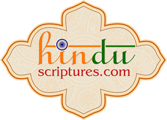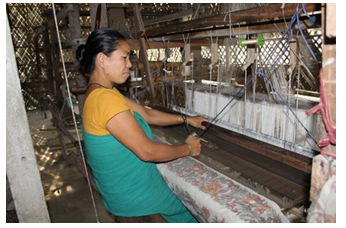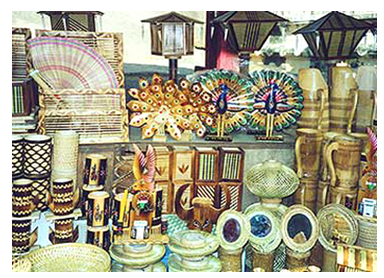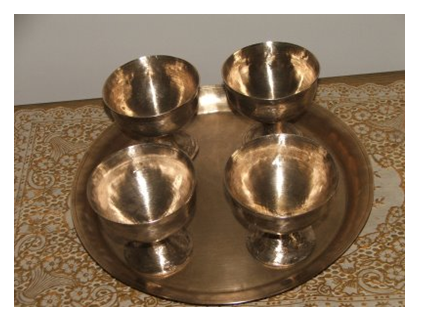TRADITIONAL CRAFTS OF ASSAM
Contents
· Weaving
· Cane and Bamboo
· Wood Craft
· Pottery and Terracotta
· Metal Crafts
· Toys
· Masks
· Jewellery
Weaving
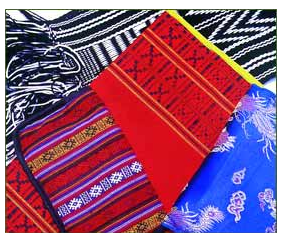
Weaving and embroidery is an integral part of Assamese crafts. The most popular Assamese traditional garment is the Mekhela – Chadar, the two-piece ladies apparel with beautifully designed borders. There are three types of silk produced in Assam in the town of Sualkuchi in Guwahati known as Muga Silk, Paat Silk and Eri silk which reflect the rich tradition and culture of weaving in Assam. This skill has been passed down from generation to generation and aesthetic and colourful designs and patterns are woven. The Muga Silk is considered the King of Silks and is golden yellow in appearance. It is extracted from the silkworm common only to this region. It is greatly in demand locally and overseas and is used to make saris and chaddars. The Paat silk or Mulberry silk is extracted from the silkworm which feeds on mulberry leaves. It is a bright and shiny silver colour and is in great demand all over the world. The Eri silk is made by silkworms which harbours on the castor oil plant and is used to make quilts and shawls. They are initially slightly coarse but after regular use become smooth and soft. Since it is porous in quality and thermal in nature it can be used in both summer and winter.
The images of human figures, flowers, creepers, birds are very commonly found embroidered upon the handloom products. The most common products are jackets, shawls, sarees, gamocha, mats, napkins and table spreads. Sualkuchi and Cachar districts are the main hubs of silk weaving. Wood fiber is also used for weaving purposes and the main hubs are Nagaon and Dhubri districts.
Cane and Bamboo
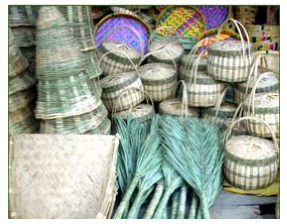
Assam has a lot of hills and forests which have vast expanses of canes and bamboos. These are used extensively by the craftsmen of the region. A number of items are for domestic use mainly in household articles like baskets, mugs, furniture, roof tiles etc. Colourful designs and beautiful motifs are also incorporated into the design.
One of the most important products of Assam is the traditional sunshade of Assam known as Japi. It is used mainly by the open air workers like the farmers and is made of strips of bamboo and dried palm leaves (tokow paat). The Japis are also used as decorative items and souvenirs for tourists. Bamboo baskets are also famous and are made in a variety of shapes and patterns. They are used for carrying and storing items like paddy, rice and betel nuts and are called Duli or Tali for the big ones and Khorahi for the small ones. There are others called Tukuri and the baskets are generally made by the men. Besides these musical instruments, toys, mats, domestic furniture, fishing apparatus etc are also made from bamboo and cane. In the villages bamboo is also used as folk medicine to treat diseases like ulcers, diabetes and hypertension.
Woodcraft
Another important and traditional craft of Assam is wood carving. The woodcraft industry is carried out by the group of people called the Khonikors. Due to the presence of abundance of forests in Assam rare collection of woods like sandalwood, agaru, vata, salmani etc are found which has facilitated the growth of the woodcraft industry. Items like tables, chairs, stools engraved with figures of animals, birds etc are made for domestic use. The decorative panels, walls and doors of houses have exquisite carvings and these artisans were appreciated and encouraged by the earlier Ahom rulers whose royal palaces were decorated by the Khonikars. The rulers even constructed for them a separate village named Khonikargaon. The prayer houses (Kirtanghars or Naam ghars) and Vaishnavite monasteries (Satras) of Assam are a testimony to the artistic creations of the Khonikars. The throne or Singhasan, the walls, ceilings and doors of the temple have beautiful engravings of the various deities like Hanuman, Garuda, Ananta etc.
Pottery and Terracotta
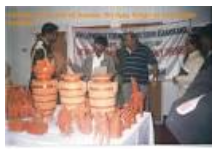
Pottery can be traced back to a number of centuries and the Kumhars and the Hiras are the traditional potter communities though the Kumhars use the wheel while the Hiras do not use the wheel. In the Hira community only women engage in pottery work while men procure raw materials and sell the finished products. The pottery products include lamps, pitchers, pots and decorative items. Terracota artisans specialise in traditional forms of Gods and Goddesses and toys, images of animals, birds etc. Terracotta is an object of art made of a composition of clay and sand baked with an earthen colour a brownish red and is derived from the Italian word Terra meaning earth and cotta meaning statue. Gauripur is very famous for its terracotta products.
Metal Crafts
Bell metal and brass is one of the oldest cottage industries and these products are famous throughout the world. Utensils like Xorai which is the traditional symbol of the state and Bota made from them are used in every household to welcome guests with paan (stuffed betel leaves). Bell metal utensils like bati (bowl), kahi (plate) etc are very beneficial as they prevent food from getting spoilt fast. Innovative and skilled designs and patterns are made by the artisans and decorative articles are famous with the tourists. The Hajo and Sarthebari villages of Kamrup district are very famous for the bell metal and brass works. The products made here are Kalash (water pot), Bati (bowl), Kahi (dish) and Tal (cymbals).
Toys
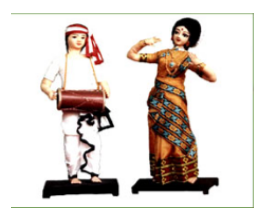
Toy making is an important industry as toys depict the way of living and lifestyle of a region giving a glimpse into the customs and heritage of a place. Toys in Assam are of four types namely cork or pith toys, wooden toys, clay toys and cloth or cloth-mud toys. Cork or pith is used to make figurines of animals, gods and goddesses. Bamboo or wooden toys are made to depict different figures of humans, birds and animals and are generally used in puppet shows. Clay is used to make figurines of mother and child, dolls depicting brides and grooms, animals, Gods and Goddesses and are made by the traditional Kumar and Hira communities. Cloth toys or toys made from a mixture of cloth and mud are used to make figurines of humans, animals and birds and are also used for puppet shows. Cloth toy skills are considered to have great importance and are passed on from generation to generation to keep the culture and tradition of the place alive.
Masks

One of the basic handicrafts of Assam is the Masks or Mukhas which revolve around the folktales and tribal myths. These are worn mostly during theatres and represent local Gods and Goddesses, historical figures or characters from the Epics. They are made from a range of materials like bamboo, pith, wood, metal and terracotta. There are simple masks that just cover the face while there are complex masks that cover the entire body. They are divided into three types depending on their sizes Cho mask, Lotokoi mask and Mukh mask. The Cho mask is made of two parts head and body and is the biggest in size. The Lotokoi mask is a smaller version of the Cho mask while the Mukh mask only covers the face. The masks of the Majuli area of Assam are unique and famous as they are light in weight and are made of clay, cloth or bamboo. The skill of making masks is passed on under the guidance of a teacher in a Satra or from generation to generation. The process of making the mask is laborious wherein bamboo strips are split to form the frame and layers of cloth dipped in clay are pasted and finally dried under the sun. It takes 10 to 15 days to complete the making of a mask. The final touching up of the masks is done with vegetable or earth colours of red and yellow. In recent times to give a better effect chemical dyes are used and they are used as decorative items in houses and taken as souvenirs by tourists.
Jewellery
The traditional jewellery of Assam is worn during religious and cultural events and they include Gam- Kharu (Large bracelet of gold or silver with a clasp), Loka Paro (Ear ring embellished with twin birds placed one after the other in gold, ruby, mina or enamel coating), Jethi Pota (a wide band of cloth placed as a row of small medallions with a central pendant), Kopou-Phool (a special type of earring resembling an orchid), Kerumoni, Thuriya, Doog-dogi, Muthi-kharu etc. This rich collection of jewellery is made from gold and the artisans are generally from a special tribe known as Sonowal Kacharis. Silver is also used in jewellery making. The designs and patterns are unique and are in vibrant colours.
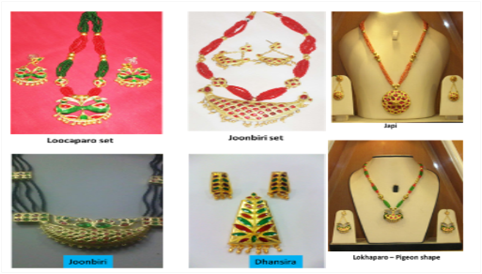
View/s: 5962 Comment/s: 1
